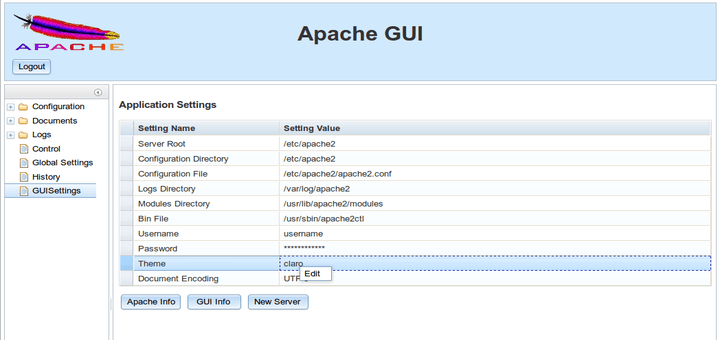To allow ec2-user to manage files in the default root directory for your Apache web server, modify the ownership and permissions of the /var/www directory. There are many ways to accomplish this task. In this tutorial, you add ec2-user to the apache group, to give the apache group ownership of the /var/www directory and assign write permissions to the group. Apache Web Server, Java Web Services - Hello World Tutorial closed Ask Question Asked 9 years, 3 months ago. Active 6 years, 11 months ago. Viewed 17k times.
Requirements for Using Apache Web Server
For the Apache Web Server, your installation must meet the minimum requirements,depending on the version of Apache.
Minimum Requirements for Apache 1.3
With Apache 1.3, the load balancer plug-in requires:
openssl-0.9.8b (source)
mod_ssl-2.8.n-1.3.x (source), where n representsthe correct version of mod_ssl for your version of Apache,and x represents the version of Apache
gcc-3.3-sol9-sparc-local packages (forSolaris 9 SPARC)
gcc-3.3-sol9-intel-local packages (forSolaris 9 x86)
The preinstalled gcc (for Solaris 10)
flex-2.5.4a-sol9-sparc-local packages (forSolaris 9 SPARC)
flex-2.5.4a-sol9-intel-local packages (forSolaris 9 x86)
The preinstalled flex (for Solaris 10)
The software sources are available at http://www.sunfreeware.com.
For more information on mod_ssl, including the correctversion of mod_ssl to use with your version of Apache,see http://www.modssl.org.
In addition, before compiling Apache:
On the Linux 2.1 platform, install Sun Java System Application Server onthe same machine.
On the Solaris 9 operating system, use pkgadd toinstall gcc and flex. Note that pkgadd requires root access.
On the Solaris 9 operating system, ensure that gcc version3.3 and make are in the PATH, and flex is installed.
On the Solaris 10 operating system, on Java Enterprise Systeminstallations, before running make for OpenSSL, run mkheaders, located in /usr/local/lib/gcc-lib/sparc-sun-solaris2.9/3.3/install-tools on Solaris SPARC or /usr/local/lib/gcc-lib/i386-pc-solaris2.9/3.3/install-tools on Solaris x86.
If you are using gcc on Red Hat EnterpriseLinux Advanced Server 2.1, the version must be later than gcc 3.0.
To use C compiler other than gcc, set the pathof the C compiler and make utility in the PATH environment variable. For example,with the sh shell: export LD_LIBRARY_PATH=$LD_LIBRARY_PATH:application-server-install-dir/lib
Minimum Requirements for Apache 2
With Apache 2, the load balancer plug-in requires:
openssl-0.9.8b (source)
httpd-2.0.49 (source)
gcc-3.3-sol9-sparc-local packages (forSolaris 9 SPARC).
gcc-3.3-sol9-intel-local packages (forSolaris 9 x86)
The preinstalled gcc (for Solaris 10)
flex-2.5.4a-sol9-sparc-local packages (forSolaris 9 SPARC)
flex-2.5.4a-sol9-intel-local packages (forSolaris 9 x86)
The preinstalled flex (for Solaris 10)
The software sources are available at http://www.sunfreeware.com
In addition, before compiling Apache:
On the Linux platform, install Sun Java System Application Server onthe same machine.
On the Solaris 9 operating system, use pkgadd toinstall gcc and flex. Note that pkgadd requires root access.
On the Solaris 9 operating system, ensure that gcc version3.3 and make are in the PATH, and flex is installed.
On the Solaris 10 operating system, before running make forOpenSSL, run mkheaders, located in /usr/local/lib/gcc-lib/sparc-sun-solaris2.9/3.3/install-tools on Solaris SPARC or /usr/local/lib/gcc-lib/i386-pc-solaris2.9/3.3/install-tools on Solaris x86.
If you are using gcc on Red Hat EnterpriseLinux Advanced Server 2.1, the version must be later than gcc 3.0.
To use a C compiler other than gcc, set thepath of the C compiler and make utility in the PATH environmentvariable.
1.5 Installation of Apache Tomcat in Eclipse Development Environment
Eclipse is a very powerful development environment for Java. For Web Development project you need Web Server. Apache Tomcat is the best production ready web container.
How to Install Eclipse for Java
These installation steps are written for windows user.
Step-1
Install JDK. To use Eclipse for Java programming, you need to first install Java Development Kit (JDK). If you have not installed JDK in your system Read 'How to Install JDK (on Windows)'.
Step-2
Download Eclipse from http://www.eclipse.org/downloads. For web development, choose 'Eclipse IDE for Java EE Developers' (32-bit or 64-bit) (e.g., 'eclipse-jee-mars-R-win32-x86_64.zip').
Step-3
Unzip the downloaded file into a directory of your choice.
There is no need to run any installer. Moreover, you can simply delete the entire Eclipse directory when it is no longer needed (without running any un-installer).
Setup and Install Apache Tomcat Server in Eclipse Development Environment
By default when you download Eclipse IDE, it doesn’t come with Tomcat install with it. Follow all detailed steps to configure Apache Tomcat successfully in Eclipse environment.

Step-1

Download Apache Tomcat from this link http://tomcat.apache.org/
click Download -> Tomcat 8.0
Choose Binary Distributions Core: 32-bit Windows zip / 64-bit Windows zip
Step-2
Extract it to Document folder.
Step-3
- Open Eclipse Environment
- Click on Servers Tab
- Click on No servers are available. Click this link to create a new server...
Apache Tomcat Web Server Javax.servlet
- Click Tomcat v8.0 Server and Next
Step-4
Select Apache installation Directory and click Finish.
Step-5
You should see Tomcat v8.0 Server at localhost [Stopped, Republish] under Servers tab.
Step-6
Now select the Server and click Start.
Apache Web Server Java Interview
Now it should be up and running on port 8080. In next section we will create our first servlet program in eclipse..
